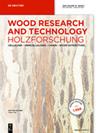The impact of site on tree form, wood properties, and lumber quality of plantation-grown Pinus patula
IF 1.6
3区 农林科学
Q2 FORESTRY
引用次数: 0
Abstract
South Africa is a water scarce country with minimal natural forests. Plantation forest species such as the Mexican tropical hard pine,地点对人工种植松树的树形、木材特性和木材质量的影响
南非是一个缺水国家,天然森林极少。为了满足当地的纤维需求,该国引进了墨西哥热带硬松(Pinus patula Schiede & Deppe ex Schltdl.如今,南非大部分的松树种植园都位于姆普马兰加省。该省的气候和土壤条件各不相同。我们在树龄均匀的 P. patula 人工林中建立了样地,并根据土壤母质和海拔高度进行了分层。根据气候和土壤特性对每个样地的生长条件进行了描述。共测量了 540 棵样树的高度、直径、密度和晚材含量。样本树被采伐后产生了 2690 根原木。原木经过碾磨后,根据密度、动态弹性模量和断裂模数对木材进行分级。年最高气温对树木生长的影响最大,而降雨量则与立木的木材密度和晚材含量相关。然而,年最高气温和树高与木材的恢复特性和尺寸稳定性呈负相关。春季降雨似乎是影响木材捻度的最重要因素,这可能是由于树木中存在较大的幼核。
本文章由计算机程序翻译,如有差异,请以英文原文为准。
求助全文
约1分钟内获得全文
求助全文
来源期刊

Holzforschung
工程技术-材料科学:纸与木材
CiteScore
4.60
自引率
4.20%
发文量
83
审稿时长
3.3 months
期刊介绍:
Holzforschung is an international scholarly journal that publishes cutting-edge research on the biology, chemistry, physics and technology of wood and wood components. High quality papers about biotechnology and tree genetics are also welcome. Rated year after year as one of the top scientific journals in the category of Pulp and Paper (ISI Journal Citation Index), Holzforschung represents innovative, high quality basic and applied research. The German title reflects the journal''s origins in a long scientific tradition, but all articles are published in English to stimulate and promote cooperation between experts all over the world. Ahead-of-print publishing ensures fastest possible knowledge transfer.
 求助内容:
求助内容: 应助结果提醒方式:
应助结果提醒方式:


